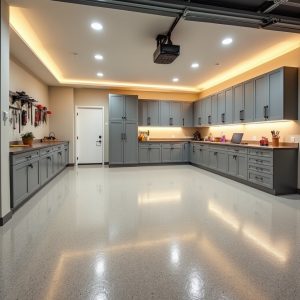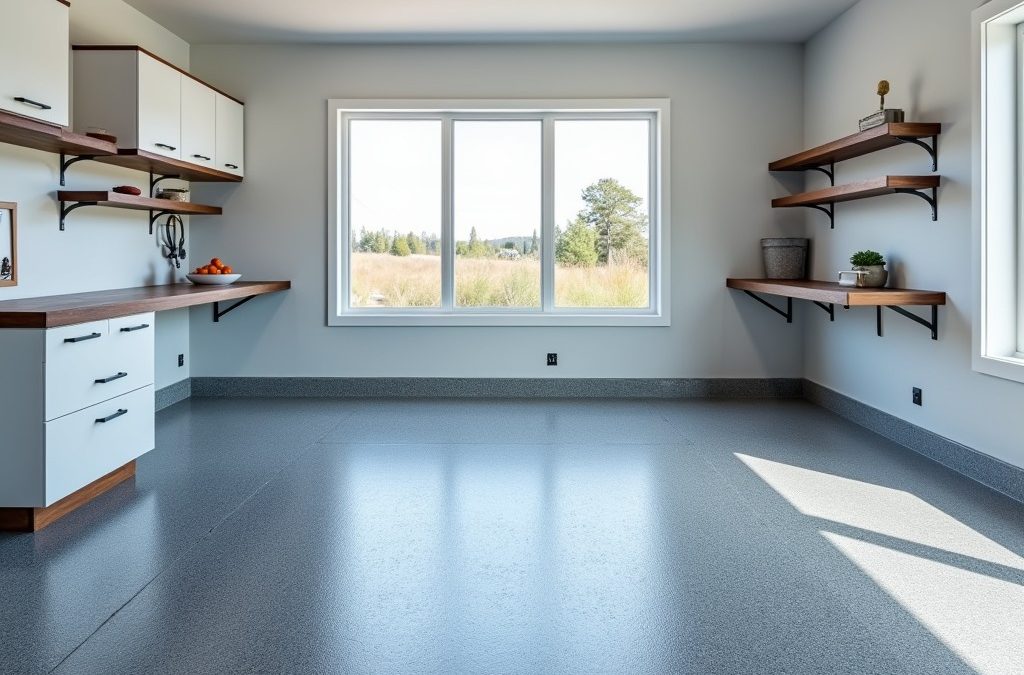Polyshield floors are a type of flooring system that is known for its exceptional durability and resistance to wear and tear. These floors are made from a combination of polyurethane and other protective materials, which gives them their unique properties. Polyshield floors are commonly used in commercial and industrial settings where heavy foot traffic and potential chemical exposure are concerns.
They are also gaining popularity in residential spaces due to their longevity and low maintenance requirements. Polyshield floors come in various forms, including epoxy and polyurea coatings, as well as polyurethane concrete overlays. These options provide different levels of protection and aesthetic appeal, making them suitable for a wide range of applications.
Whether it’s a garage, warehouse, showroom, or even a residential kitchen, polyshield floors offer a versatile solution for high-traffic areas that require a durable and long-lasting flooring system.
Key Takeaways
- Polyshield floors are a type of flooring that offers durability, resistance to stains and scratches, and a high level of protection for your space.
- The benefits of Polyshield floors include easy maintenance, long-lasting durability, and a wide range of design options to suit any space.
- The installation process for Polyshield floors involves preparing the subfloor, applying the Polyshield coating, and allowing it to cure for a seamless and durable finish.
- To maintain and care for Polyshield floors, regular sweeping and mopping with a mild detergent is recommended, along with avoiding harsh chemicals and abrasive cleaning tools.
- When comparing Polyshield floors to other flooring options, consider factors such as durability, maintenance requirements, and cost to determine the best fit for your space.

Benefits of Polyshield Floors
The benefits of polyshield floors are numerous, making them a popular choice for both commercial and residential spaces. One of the primary advantages of polyshield floors is their exceptional durability. These floors can withstand heavy loads, impact, abrasion, and chemical exposure, making them ideal for environments where traditional flooring materials may fail.
In addition to their durability, polyshield floors are also highly resistant to stains, making them easy to clean and maintain. Their seamless and non-porous surface prevents liquids and contaminants from seeping into the floor, reducing the risk of bacterial growth and making them an excellent choice for spaces that require strict hygiene standards. Furthermore, polyshield floors are available in a wide range of colors and finishes, allowing for customization to match the aesthetic requirements of any space.
Whether it’s a sleek, high-gloss finish for a showroom or a more subtle matte finish for a residential garage, polyshield floors offer versatility in design without compromising on performance.
Installation Process of Polyshield Floors
The installation process of polyshield floors typically involves several steps to ensure a proper and long-lasting application. The first step is surface preparation, which includes cleaning the existing substrate and repairing any cracks or imperfections. This is crucial to ensure proper adhesion of the polyshield coating and to prevent any issues with the finished floor.
Once the surface is prepared, the next step is the application of the polyshield material. Depending on the specific type of polyshield floor chosen, this may involve mixing and applying epoxy or polyurea coatings, or pouring and spreading polyurethane concrete overlays. Proper application techniques are essential to achieve a smooth and uniform finish that will provide the desired level of protection and aesthetics.
After the initial application, the polyshield floor may require additional curing time before it can be put into full use. This curing process allows the material to fully harden and bond to the substrate, ensuring maximum durability and longevity. Professional installation by experienced contractors is recommended to ensure that the polyshield floor is applied correctly and will perform as intended.
Maintenance and Care Tips for Polyshield Floors
| Tip | Description |
|---|---|
| Clean Regularly | Use a damp mop or cloth to clean the floor regularly to remove dirt and debris. |
| Avoid Harsh Chemicals | Avoid using harsh chemicals or abrasive cleaners that can damage the polyshield floor. |
| Use Furniture Pads | Place furniture pads under heavy furniture to prevent scratching and denting the floor. |
| Wipe Spills Immediately | Wipe up spills immediately to prevent staining and damage to the floor. |
| Use Area Rugs | Use area rugs in high-traffic areas to protect the polyshield floor from wear and tear. |
Maintaining polyshield floors is relatively straightforward, thanks to their durable and non-porous nature. Regular cleaning with a mild detergent and water is usually sufficient to keep the floor free from dirt and debris. For tougher stains or spills, a non-abrasive cleaner can be used without damaging the floor’s surface.
It’s important to avoid using harsh chemicals or abrasive cleaning tools on polyshield floors, as these can degrade the protective coating and compromise its performance. Additionally, placing protective pads under heavy furniture and equipment can help prevent scratches and dents on the floor’s surface. Periodic inspections for any signs of wear or damage are also recommended to address any issues before they escalate.
If any areas of the floor show signs of wear, it’s essential to have them repaired promptly to maintain the integrity of the entire flooring system.
Comparing Polyshield Floors to Other Flooring Options

When comparing polyshield floors to other flooring options, several key factors come into play. In terms of durability, polyshield floors outperform many traditional flooring materials such as tile, hardwood, or vinyl. Their resistance to impact, abrasion, and chemical exposure makes them a superior choice for high-traffic areas and industrial environments.
In terms of maintenance, polyshield floors require minimal upkeep compared to many other flooring options. Unlike hardwood floors that require regular refinishing or carpet that needs frequent vacuuming, polyshield floors only need basic cleaning to maintain their appearance and performance. Aesthetically, polyshield floors offer a wide range of customization options that may not be available with other flooring materials.
From color choices to finish options, polyshield floors can be tailored to suit the design preferences of any space while still providing exceptional durability.
Polyshield vs. CycloSpartic™: Where the Real Difference Lies
While “Polyshield” is a general category encompassing multiple materials (including epoxy and polyurea), CycloSpartic™ is a next-generation coating system engineered specifically to overcome the shortcomings of those traditional solutions:
| Feature | Polyshield (Epoxy/Polyurea) | CycloSpartic™ |
|---|---|---|
| Cure Time | Can take up to 24+ hours | Cures in under 24 hours |
| UV Resistance | Varies; often fades or yellows | Guaranteed UV-stable—no yellowing |
| Adhesion & Flexibility | May crack under thermal expansion | Flexible, won’t crack or peel |
| Chemical Resistance | Moderate to strong | Exceptionally high |
| Warranty | Typically 1–15 years | Lifetime Residential Warranty |
| Application Sensitivity | Weather-dependent | Tolerates wide range of temps & humidity |
In short: Polyshield does the job. CycloSpartic™ elevates the entire category.
Installation Process: Similar Surface, Better Science
Like Polyshield floors, CycloSpartic™ coatings start with a thorough preparation process. Subfloors are cleaned and repaired, then the coating is applied in layers. But unlike older polyurea or epoxy systems, CycloSpartic™ bonds more effectively, cures faster, and maintains its integrity even in less-than-ideal installation conditions.
This gives contractors and homeowners more flexibility—and fewer callbacks.
Cost Considerations for Polyshield Floors
Long-term Durability and Low Maintenance
While the initial investment in polyshield floors may be higher than some traditional flooring options, their long-term durability and low maintenance requirements often make them a cost-effective choice over time. It’s important to consider the total cost of ownership when evaluating polyshield floors compared to other flooring options.
Reduced Maintenance and Repair Costs
While the upfront cost may be higher, the reduced need for repairs, replacements, and ongoing maintenance can result in significant cost savings in the long run.
A Durable and Sustainable Flooring Choice
Additionally, the longevity of polyshield floors should be factored into cost considerations. With proper care and maintenance, polyshield floors can last for many years without needing replacement, making them a durable and sustainable flooring choice.
Choosing the Right Polyshield Floor for Your Space
When choosing the right polyshield floor for a specific space, several factors should be taken into account. The intended use of the space, the level of foot traffic it will experience, and any specific aesthetic requirements will all influence the selection of the most suitable polyshield material and finish. For high-traffic commercial or industrial spaces, a more robust polyurea coating or polyurethane concrete overlay may be preferred for their exceptional durability.
In contrast, residential spaces may benefit from epoxy coatings with a wider range of color options to match specific design preferences. It’s also essential to consider any specific performance requirements such as chemical resistance or anti-slip properties when selecting a polyshield floor. Consulting with experienced flooring professionals can help ensure that the chosen polyshield floor meets all necessary criteria for the intended space.
Polyshield floors often come with lower upfront costs. However, CycloSpartic™ coatings are designed to reduce:
-
Reapplication frequency
-
Surface discoloration or peeling
-
Repairs from cracking or delamination
That means a higher return on investment over time—especially when backed by a lifetime warranty.
In conclusion, polyshield floors offer a durable, low-maintenance flooring solution suitable for a wide range of applications. Their exceptional durability, resistance to stains and chemicals, customizable aesthetics, and long-term cost-effectiveness make them an attractive choice for both commercial and residential spaces. By understanding the installation process, maintenance requirements, cost considerations, and factors influencing material selection, individuals can make informed decisions when choosing polyshield floors for their specific needs.
FAQs
What are Polyshield Floors?
Polyshield floors are a type of flooring that is made from a combination of polyurethane and other protective materials. This creates a durable and long-lasting surface that is resistant to scratches, stains, and other damage.
Benefits of Polyshield Floors
Polyshield floors offer several benefits, including durability, resistance to damage, easy maintenance, and a wide range of design options. They are also water-resistant, making them suitable for use in kitchens, bathrooms, and other high-moisture areas.
Installation Process of Polyshield Floors
The installation process for polyshield floors typically involves preparing the subfloor, applying the polyshield material, and allowing it to cure. The specific process may vary depending on the type of polyshield flooring being installed.
Maintenance and Care Tips for Polyshield Floors
To maintain polyshield floors, it is important to regularly sweep or vacuum to remove dirt and debris. Spills should be wiped up promptly, and the floors can be cleaned with a damp mop using a mild cleaner. Avoid using harsh chemicals or abrasive cleaning tools.
Comparing Polyshield Floors to Other Flooring Options
Polyshield floors offer advantages over other flooring options such as hardwood, laminate, and tile. They are more durable and resistant to damage, making them a good choice for high-traffic areas.
Cost Considerations for Polyshield Floors
The cost of polyshield floors can vary depending on factors such as the type of polyshield material, the size of the space being covered, and the complexity of the installation. It is important to consider both the upfront cost and the long-term durability when comparing the cost of polyshield floors to other options.
Choosing the Right Polyshield Floor for Your Space
When choosing a polyshield floor, consider factors such as the level of foot traffic in the space, the desired design aesthetic, and the specific requirements for maintenance and care. It is also important to consider any specific installation requirements for the chosen type of polyshield flooring.
To find the ideal floor coating for your space, reach out to one of our Garage Force locations today and consult with a floor coating expert.

